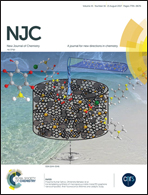Influence of a D–π–A system through a linked unit of double and triple bonds in a triarylene bridge for dye-sensitised solar cells†
Abstract
Herein, eight metal-free organic dyes (YH-1–YH-8) containing olefin or acetylene as π-spacer linkages in a triarylene bridge were synthesised. Moreover, two dyes (1N-PPP and 1N-PPS) without olefin and triple bonds as π-spacer linkages were used as references. The photophysical and electrochemical properties of the dyes were characterised, and the dyes were then used to fabricate dye-sensitised solar cells (DSSCs). We demonstrated the use of a D–π–A dipolar system by employing arylamine derivatives as an electron donor, triarylene with iterative olefin or acetylene as a π-bridge, and cyanoacrylic acid as an electron acceptor. YH-1 had olefin as a repeating unit in the triarylene bridge and exhibited broad absorption, favourable short-circuit photocurrent density (Jsc), and favourable open-circuit voltage (Voc) when used in a film morphology with DCA as a coabsorbent. The optimal device exhibited a Jsc of 16.23 mA cm−2, a Voc of 650 mV, and a fill factor of 0.67, corresponding to an overall conversion efficiency of 7.08%. The photophysical properties of the DSSCs were analysed using time-dependent density functional theory with the B3LYP functional.



 Please wait while we load your content...
Please wait while we load your content...